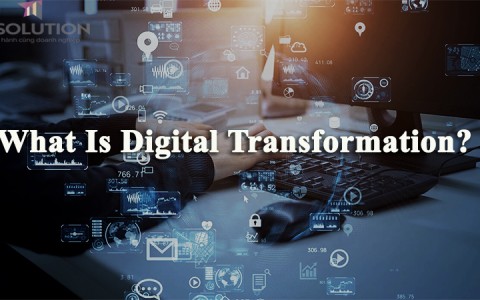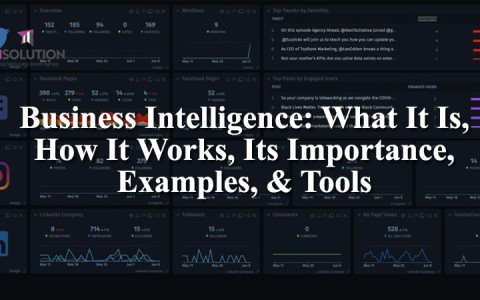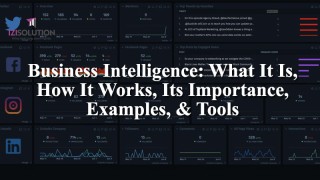What is digital transformation?
What is digital transformation?
Because digital transformation will look different for every company, it can be hard to pinpoint a definition that applies to all. However, in general terms, we define digital transformation as the integration of digital technology into all areas of a business resulting in fundamental changes to how businesses operate and how they deliver value to customers.

Beyond that, it's a cultural change that requires organizations to continually challenge the status quo, experiment often, and get comfortable with failure. This sometimes means walking away from long-standing business processes that companies were built upon in favor of relatively new practices that are still being defined.
Why does digital transformation matter?
A business may take on digital transformation for several reasons. But by far, the most likely reason is that they have to: It's a survival issue. In the wake of the pandemic, an organization's ability to adapt quickly to supply chain disruptions, time to market pressures, and rapidly changing customer expectations has become critical.

And spending priorities reflect this reality. According to the May, 2020 International Data Corporation (IDC) Worldwide Digital Transformation Spending Guide, spending on the digital transformation (DX) of business practices, products, and organizations continues "at a solid pace despite the challenges presented by the COVID-19 pandemic." IDC forecasts that global spending on DX technologies and services will grow 10.4 percent in 2020 to $1.3 trillion. That compares to 17.9 percent growth in 2019, "but remains one of the few bright spots in a year characterized by dramatic reductions in overall technology spending," IDC notes.
At a recent MIT Sloan CIO Symposium series event, IT leaders agreed that consumer behavior has quickly shifted in many ways since the start of the pandemic. Sandy Pentland, a professor at the MIT Media Lab, described how optimized automated systems in areas like supply chain management broke down when faced with rapid shifts in both demand and supply — a reality that just about everyone has faced on a personal level during the pandemic.
It's early to guess which long-term consumer behavior changes will stick. However, Rodney Zemmel, global leader, McKinsey Digital of McKinsey & Company, says that on the consumer side "digital has been accelerating in just about all categories." An important factor to watch will be the degree to which forced change — three out of four Americans tried a new shopping behavior, for example — will revert when possible, post today's emphasis on stay-in-place.
McKinsey data shows that the accelerated shift towards streaming and online fitness is likely to stay permanently, Zemmel says. But the biggest shifts were around food. Both home cooking and online grocery shopping — a category that has been generally resistant to getting moved online — will probably stay more popular with consumers than in the past. Cashless transactions are also gaining steam. On the B2B side, McKinsey data shows remote selling is working.
For CIOs, this means rapid experimentation is no longer optional.
Mark Anderson, senior director of solution architecture, Equinix, described this year as "a forced test of many things we had thought about but not tried." For example, he observed, "Many supply chains are not well understood and underpinned with paper. We've started looking at technologies like blockchain and IoT."
As Dion Hinchcliffe, VP and principal analyst at Constellation Research, writes: "The top IT executives in today's rapidly evolving organizations must match the pace of change, fall behind, or lead the pack. That's the existential issue at stake in today's digitally-infused times, where bold action must be actively supported by out-of-the-box experimentation and pathfinding. This must be done while managing the inexorable daily drumbeat of operational issues, service delivery, and the distracting vagaries of the unpredictable, such as a major cyberattack or information breach."
Improving customer experience has become a crucial goal – and thus a crucial part of digital transformation. Hinchcliffe calls seamless customer experience "the most important discriminating factor for how a business will perform."
How has the COVID-19 pandemic changed digital transformation?
"We've seen the COVID crisis rapidly re-shape both the "what" and the "how" of companies' digital transformation agendas, notes Korn Ferry's Swift.

Take employee experience for example, she suggests. "Even as employee experience has become a key theme in the HR community, in IT circles this notion had been getting a mixed reception – sometimes stereotyped as "spoiled employees expecting best-in-class consumer-grade tech on shoestring budgets," says Swift.
"Today, with a vast portion of the workforce now remote, employee experience of digital technology has gone from "nice to have" to "the only way work gets done. Consequently, it's getting the problem-solving focus it likely long deserved."
Swift calls out some other areas of digital transformation efforts that COVID-19 pushed higher on CIO agendas:
-
Furthering the reach of customer support via tools including chatbots
-
Automation tools for resilience reasons
-
Radical housecleaning of redundant or conflicting systems
In response to the pandemic, CIOs have also embraced the notion that "the perfect is the enemy of the good," Swift adds. "Nothing silences an individual's – or an organization's – inner perfectionist like a full-blown crisis. In response to dramatic disruption, many organizations have undergone a healthy re-negotiation of their relationship to digital technology – prioritizing "hey, it works!" over "after years of slaving over this initiative, we've assembled the very best bells and whistles." The "working software" lionized in the Agile Manifesto is getting a true moment in the sun." (For more, read Swift's full article: Digital transformation: 5 ways COVID-19 is forcing positive changes.)
Enterprise Digital Transformation Framework
Although digital transformation will vary widely based on organization's specific challenges and demands, there are a few constants and common themes among existing case studies and published frameworks that all business and technology leaders should consider as they embark on digital transformation.
For instance, these digital transformation elements are often cited:
-
Customer experience
-
Operational agility
-
Culture and leadership
-
Workforce enablement
-
Digital technology integration
While each guide has its own recommendations and varying steps or considerations, CIOs should look for those important shared themes when developing their own digital transformation strategy
What drives digital transformation?
An important element of digital transformation is, of course, technology. But often, it's more about shedding outdated processes and legacy technology than it is about adopting new tech. It's also about enabling innovation.
In the area of government IT, for example, more government agencies are on the verge of realizing the cloud model's full potential - beyond cost-cutting to using cloud for strategic advantage, notes Dave Egts, chief technologist, North America Public Sector, Red Hat. "Deloitte recently released a list of nine technology trends transforming government, and one, in particular, will be key to enabling the future of technology in government: The cloud as an innovation driver," Egts says.
The prevalence of legacy technology in enterprise IT still hinders CIOs' ability to successfully embark on a digital transformation strategy. As Beth Devin, Managing Director and Head of Innovation Network & Emerging Technology, Citi Ventures has explained, legacy tech can become a costly barrier to transformation. "If you're spending 70 to 80 percent of the IT budget operating and maintaining legacy systems, there's not much left to seize new opportunities and drive the business forward. And this expenditure will grow as technology ages and becomes more susceptible," Devin notes.
What's more, new technologies are built using cloud architectures and approaches, she points out: "What is the long-term value of leveraging the best new technology for your business and customers?"
A critical factor driving legacy upgrades, according to a recent Deloitte survey, is technological relevance, she says. "Legacy solutions lack flexibility and carry a significant technology debt due to dated languages, databases (and) architectures," Deloitte reported. "This liability prevents many organizations from advancing and supporting analytics, real-time transactions, and a digital experience." (Read Devin's full article: Digital transformation: 9 ROI factors when upgrading legacy systems. )
If businesses want to evolve with the rapid pace of digital change today, they must work to increase efficiency with technology wherever possible. For many, that means adopting agile principles across the business. Automation technologies also help many IT organizations gain speed and reduce technical debt.
What are the key trends in digital transformation in 2022?
As Enterprisers Stephanie Overby has reported, "Ongoing digital transformation across industries became a given in 2019. At the same time, digital transformation fatigue also became very real." It's a good time to ask yourself if your team is getting tired or less engaged.

2022 will be a year of some reckoning for digital initiatives. Organizations that continue to underestimate the need for culture change do so at their own peril.
“2022 will still see the rapid scaling of digital initiatives across industries," says Steve Hall, partner and president of global technology research and advisory firm ISG. "In many areas, CIOs and organizations have prepped their organizations for change but haven't made the full leap to transforming their culture to fully embrace the change."
Here are eight key digital transformation trends that business and IT leaders should be aware of in 2022:
-
Rapid adoption of digital operating models, including integrated cross-functional teams.
-
A shakeout as those that have invested in big data governance and analytics leapfrog their competitors.
-
Better use of AI and machine learning.
-
Continued merger and acquisition activity in the IT outsourcing industry.
-
Consultancies forming new digital partnerships.
-
Expanding public cloud adoption.
-
New digital transformation success metrics.
-
More attention to long-term value of digital initiatives.
Digital transformation is a massive undertaking, especially for larger, established companies. When done right, it will produce a business that is more aligned with customer demands and resilient in the fast-moving digital future.




































